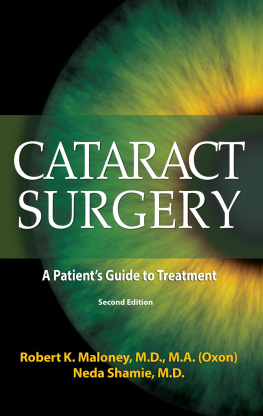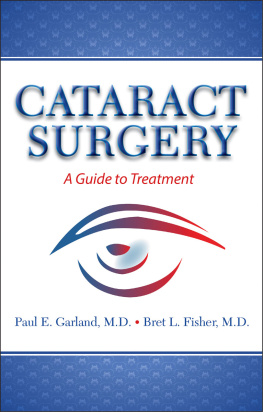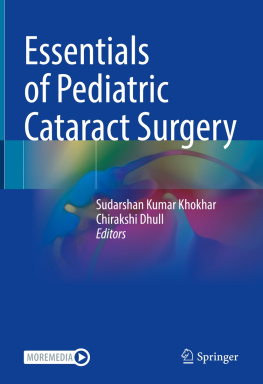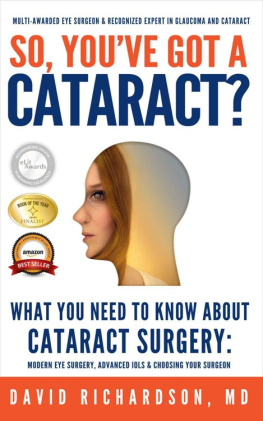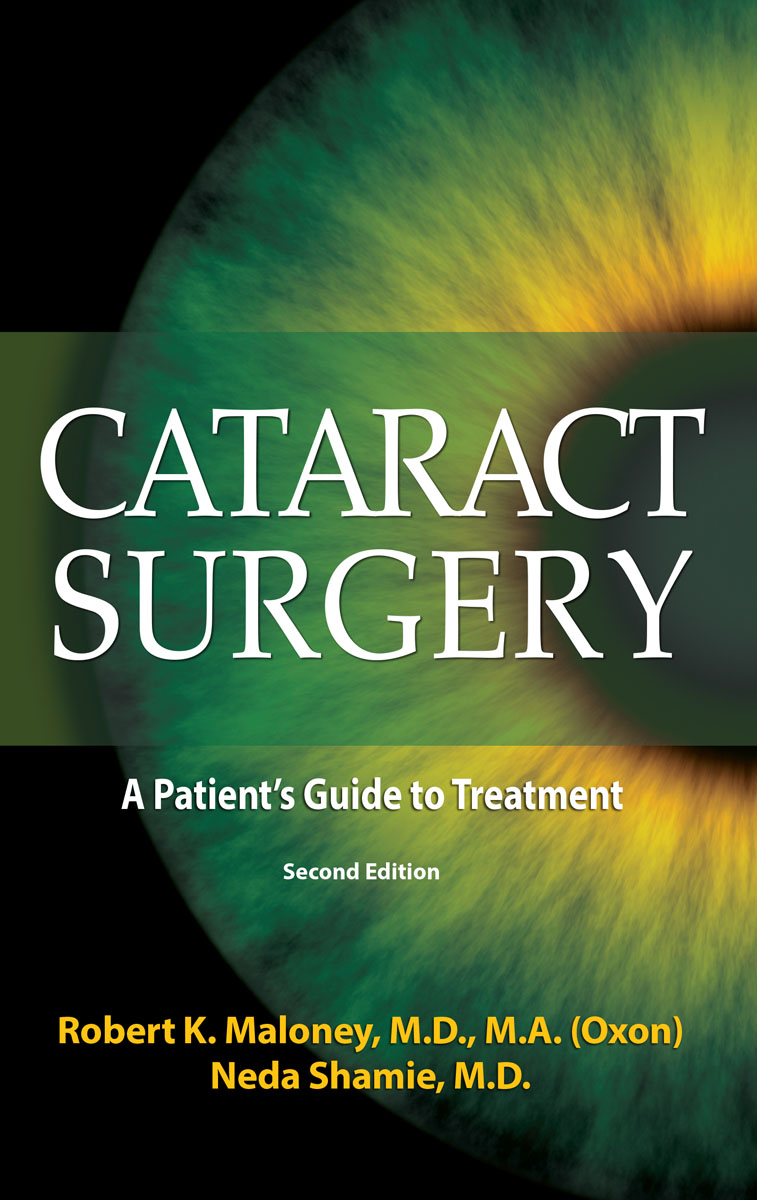
An Addicus Nonfiction Book
Copyright 2020 by Robert K. Maloney, M.D. All rights reserved. No part of this publication may be reproduced, stored in a retrieval system, or transmitted in any form or by any means, electronic, mechanical, photocopied, recorded, or otherwise, without the prior written permission of the publisher. For information, write Addicus Books, Inc., P.O. Box 45327, Omaha, Nebraska 68145.
ISBN: 978-1-950091-38-6
Illustrations by JIREHDESIGN.com
Cover design by Ryan Delaney and Jack Kusler
Interior design by Jack Kusler
This book is not intended to serve as a substitute for a physician. Nor is it the authors intent to give medical advice contrary to that of an attending physician.
Library of Congress Cataloging-in-Publication Data
Names: Maloney, Robert K., author. | Shamie, Neda, author.
Title: Cataract surgery : a patients guide to treatment / Robert
K. Maloney, M.D., M.A. (Oxon), Neda Shamie, M.D.
Description: Second edition. | Omaha, Nebraska : Addicus Books, 2020. | Includes index. |
Identifiers: LCCN 2020009730 (print) | LCCN 2020009731 (ebook) | ISBN 9781950091386 (trade paperback) | ISBN 9781950091409 (pdf) | ISBN 9781950091416 (epub) | ISBN 9781950091423 (kindle edition)
Subjects: LCSH: CataractSurgeryPopular works.
Classification: LCC RE451 .M33 2020 (print) | LCC RE451 (ebook) | DDC | 617.7/42059dc23
LC record available at https://lccn.loc.gov/2020009730
LC ebook record available at https://lccn.loc.gov/2020009731
Addicus Books, Inc.
P.O. Box 45327
Omaha, Nebraska 68145
www.AddicusBooks.com
Printed in the United States of America
10 9 8 7 6 5 4 3 2 1
To the thousands of patients who have trusted us with their most precious sensetheir sight
Contents
Acknowledgments
I wish to thank my father, who taught me to be uncompromising in the pursuit of excellence, and my mother, who taught me that great relationships require compromise. I particularly thank my fabulous wife, Nicole, for her patience with the demands of my chosen career. At times, she must wish that I had listened more to my mothers advice.
Robert K. Maloney, M.D.
I wish to thank my husband and my daughters without whose support I could not nurture my love of my chosen field. Their support allows me to maintain balance in my life and brings color and fulfillment to my days.
Neda Shamie, M.D.
Introduction
O f all the amazing components of the human anatomy, the eyes may be the most marvelous. They are your primary tools of awareness. The ability to see allows you independence, mobility, and appreciation of visual beauty and form.
If your vision is starting to blur and you think you might have cataracts, put your mind at ease. Cataracts are usually painless and are not harmful to other parts of your eyes. They are not a sign of disease, nor are they growths. They are simply a clouding of the lens of the eye. In most cases, cataracts are as normal a part of aging as the silver threads among the gold (in the words of an old song) that appear when your hair begins to gray.
Cataracts develop so gradually that you probably wont need any treatment for them at first. A stronger eyeglass prescription will likely help in the early stages. Eventually, your vision will become blurrier, some things will seem out of focus, and youll need new prescriptions more often. Objects might appear yellowish. Glare or halos from light sources could make night driving difficult. You might have trouble reading, both close up and at a distancefine print in a book, for example, and street signs along the highway. When these symptoms interfere with your day-to-day activities, you may want to consider surgery.
By age sixty-five, most Americans have early-stage cataracts, and, by age eighty, most have had cataract surgery. Surgeons perform some 3 million cataract operations a year in the United States, with a very high success rate and few complications. We are fortunate to live in a time and a place where outpatient surgery, which takes just minutes, can painlessly replace a clouded natural lens with a state-of-the-art synthetic lens. Within a day or two of your surgery, youll marvel at how clear and vivid your world has become.
In the United States, cataract surgery is among the most effective and safest surgical procedures performedespecially in the hands of a highly qualified and experienced eye surgeon. Replacement lenses do an excellent job of restoring vision (with or without glasses, depending on the type of lens implanted). Recovery is rapidyou can resume most of your normal activities within a few days.
This book describes how the healthy eye functions, how cataracts can interfere with clear eyesight, and how clarity can be restored. It explains all your options if cataracts are starting to cloud your vision. It can help you and your doctor determine the right time for surgery.
You, or someone you care about, might find great reassurance in the knowledge that cataracts can be safely and successfully treated and that, after they are removed, cataracts do not return. Advances in cataract surgery have made it possible for millions of people to enjoy the independence and the aesthetic pleasure of clear vision for decades beyond what was once possible.
The Human Eye and How It Works
T o understand how cataracts cause blurry vision, you may find it helpful to learn about the structure of the eye and how it works. The eye is a complex organ that performs many complicated functions in a very short timein the blink of an eye, one might say.
Anatomy of the Eye
If you could examine an entire human eye, youd see a sphere about an inch in diameterthe size of a large gumball. The eyeball itself is really three thin layers of tissue that surround a fluid-filled center.
Sclera
The outside layer is the white of the eye, called the sclera. It is the tough, opaque tissue that serves as the eyes structural outer layer. Six tiny muscles connect to it around the eye and control the eyes movements. The optic nerve carries the visual image from the eye to the brain.
Cornea
Curving out from the sclera, the clear cornea is the front window of the eye. It is the first layer through which light enters the eye. The cornea is tough and protects the inside of your eye from dust and germs. Packed with nerve fibers, it is also quite sensitive to pain. This pain sensitivity is one of the corneas protective qualities, signaling tearing or a brisk blink to wash out a grain of sand.
Eye Anatomy

The different parts of the eye.
Iris
Behind the clear cornea is a thin layer of colored tissue, called the iris. When we say that someones eyes are blue, brown, or green, we are talking about the color of the iris. Besides being an expressive feature of the face, the iris is essential to clear vision. It surrounds the round, black pupil. It is through the pupil that light enters the eye and allows us to see.
Lens
The

